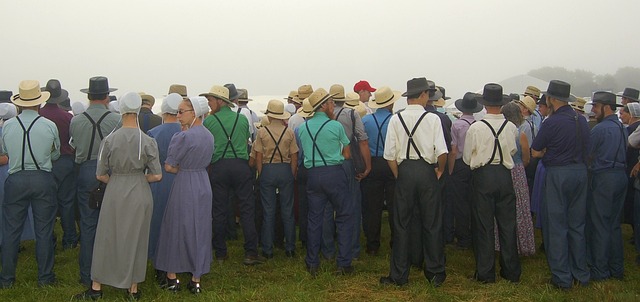The Amish and Hutterite communities are both religious groups that originated from the Anabaptist movement in Europe during the 16th century. While they share some similarities in their beliefs and practices, there are also significant differences between the two groups. This introduction will provide a brief overview of the Amish and Hutterite communities, highlighting their distinct characteristics and ways of life.
Table of Contents
History and Origins of the Amish and Hutterite Communities
The Amish and Hutterite communities are two distinct groups that have a rich history and fascinating origins. Both communities have a strong commitment to their religious beliefs and a desire to live a simple, communal lifestyle. However, there are some key differences between the two groups that have shaped their unique identities.
The Amish community traces its roots back to the 16th century in Switzerland. They are named after their founder, Jakob Ammann, who believed in strict adherence to traditional Anabaptist beliefs. The Amish faced persecution in Europe and sought refuge in America, where they settled in Pennsylvania in the 18th century. Today, there are Amish communities in several states across the country.
On the other hand, the Hutterite community has its origins in the 16th century as well, but in Austria. They were founded by Jakob Hutter, who emphasized the importance of communal living and shared property. Like the Amish, the Hutterites faced persecution and eventually migrated to America, settling primarily in the Dakotas and Canada.
One of the main differences between the Amish and Hutterite communities is their approach to technology. The Amish are known for their rejection of modern technology, preferring to live a simple, agrarian lifestyle. They believe that technology can lead to worldly temptations and a loss of community cohesion. As a result, the Amish do not use electricity, drive cars, or have telephones in their homes.
In contrast, the Hutterites have embraced certain aspects of modern technology. They use electricity and drive vehicles, although they do not own personal cars. The Hutterites believe that technology can be used for the benefit of the community, as long as it does not lead to individualism or materialism. They have also adopted modern agricultural practices, using machinery and advanced farming techniques.
Another difference between the Amish and Hutterite communities is their approach to education. The Amish prioritize a traditional education that focuses on practical skills and religious teachings. They typically end formal education after eighth grade and emphasize hands-on learning within the community. The Hutterites, on the other hand, have established their own schools within their colonies. They provide a comprehensive education that includes both academic subjects and vocational training.
Despite these differences, both the Amish and Hutterite communities share a commitment to living a simple, communal lifestyle. They value strong family and community ties and prioritize the well-being of the group over individual desires. Both communities have faced challenges and changes over the years, but they have managed to preserve their unique identities and traditions.
In conclusion, the Amish and Hutterite communities have a shared history and commitment to their religious beliefs. While they have some differences in their approach to technology and education, both groups value simplicity and communal living. The Amish and Hutterites have managed to maintain their distinct identities and traditions, making them fascinating communities to learn about and admire.
Cultural Practices and Beliefs of the Amish and Hutterite Communities

The Amish and Hutterite communities are two distinct groups that have similar roots in Anabaptist Christianity. While they both adhere to a simple and traditional way of life, there are notable differences in their cultural practices and beliefs.
One of the key differences between the Amish and Hutterites lies in their approach to technology. The Amish are known for their rejection of modern technology, preferring to live a simple and self-sufficient lifestyle. They shun electricity, cars, and other modern conveniences, believing that these advancements can lead to worldly temptations and a loss of community cohesion. On the other hand, Hutterites have embraced certain aspects of technology, such as electricity and machinery, to aid in their communal farming practices. They believe that technology can be used as a tool to enhance their way of life, as long as it does not compromise their core values.
Another area where the Amish and Hutterites differ is in their approach to education. The Amish prioritize a practical education that prepares their children for a life of manual labor and self-sufficiency. They typically end formal education after the eighth grade, focusing instead on vocational training within their community. In contrast, Hutterites place a strong emphasis on education and value higher learning. They operate their own schools within their colonies and encourage their children to pursue higher education and professional careers. This difference in educational philosophy reflects the distinct priorities of each community.
Religious practices also vary between the Amish and Hutterites. The Amish hold their religious services in private homes or barns, with each family taking turns hosting the congregation. They believe in a personal and intimate relationship with God, emphasizing the importance of community and mutual support. Hutterites, on the other hand, gather in a central meetinghouse for their religious services. They have a more structured and formal approach to worship, with a designated minister leading the congregation. Hutterites also place a strong emphasis on communal living and sharing resources, which is reflected in their religious practices.
In terms of social structure, the Amish and Hutterites have different ways of organizing their communities. The Amish live in close-knit family units, with each household operating independently. They value individual autonomy and decision-making within the family unit. In contrast, Hutterites live in communal colonies, where all property and resources are shared. They operate under a system of collective decision-making, with a designated leader or council overseeing the affairs of the community. This communal lifestyle fosters a sense of unity and cooperation among Hutterites.
Despite these differences, the Amish and Hutterites share a common commitment to their faith and a desire to live a simple and devout life. Both communities prioritize strong family values, hard work, and a rejection of materialism. They strive to maintain their cultural practices and beliefs in the face of an ever-changing world. While the Amish and Hutterites may have divergent approaches to certain aspects of life, they both serve as examples of the enduring power of faith and community in today’s society.
Education and Technology Differences between the Amish and Hutterite Communities
The Amish and Hutterite communities are both known for their traditional way of life and their commitment to living a simple and humble existence. However, when it comes to education and technology, these two communities have some notable differences.
Education is highly valued in both the Amish and Hutterite communities, but the approach to education differs significantly. The Amish believe in providing their children with a basic education that focuses on practical skills and prepares them for a life of manual labor. Formal education typically ends after the eighth grade, and children are expected to contribute to the family and community through work.
On the other hand, the Hutterites place a greater emphasis on formal education. They believe in providing their children with a comprehensive education that includes not only practical skills but also academic subjects. Hutterite children attend school until the age of 15 or 16 and are encouraged to pursue higher education if they wish to do so.
Technology is another area where the Amish and Hutterite communities differ. The Amish have a strict aversion to modern technology and believe that it can lead to a loss of community and a weakening of their faith. As a result, most Amish communities reject the use of electricity, automobiles, and other modern conveniences. Instead, they rely on traditional methods of transportation and manual labor.
In contrast, the Hutterites have a more pragmatic approach to technology. While they also value simplicity and community, they recognize the benefits that technology can bring. Hutterite communities often embrace modern conveniences such as electricity, tractors, and other labor-saving devices. However, they do so in a controlled and regulated manner, ensuring that technology does not overshadow their core values and way of life.
The differences in education and technology between the Amish and Hutterite communities can be attributed to their respective beliefs and priorities. The Amish prioritize a simple and self-sufficient lifestyle, focusing on manual labor and practical skills. They believe that a basic education is sufficient for their children to thrive in their community.
On the other hand, the Hutterites value education as a means of personal growth and development. They believe that a comprehensive education, including academic subjects, will equip their children with the skills and knowledge necessary to succeed in the modern world. They also recognize the benefits that technology can bring, as long as it is used in a way that aligns with their values and does not compromise their way of life.
In conclusion, the Amish and Hutterite communities have different approaches to education and technology. The Amish prioritize practical skills and manual labor, providing their children with a basic education that prepares them for a life within their community. The Hutterites, on the other hand, value formal education and recognize the benefits that technology can bring, as long as it is used in a way that aligns with their values. These differences reflect the unique beliefs and priorities of each community, and contribute to their distinct way of life.
Social Structures and Community Life in Amish and Hutterite Societies
Amish and Hutterite societies are both known for their unique social structures and strong sense of community. While they share some similarities, there are also distinct differences between the two groups. In this article, we will explore the social structures and community life in Amish and Hutterite societies.
Both the Amish and Hutterites are religious groups that emphasize communal living and a simple way of life. However, their social structures differ in several ways. The Amish live in close-knit, tight-knit communities, often consisting of extended family members. They value individualism and self-sufficiency, with each family having their own farm and household. In contrast, the Hutterites live in larger, more structured communities called colonies. These colonies are made up of multiple families who live and work together, sharing resources and responsibilities.
In Amish communities, decision-making is typically done through a consensus-based approach. The community members gather together to discuss and make important decisions that affect the entire group. This democratic process ensures that everyone has a say and that decisions are made collectively. On the other hand, Hutterite colonies have a more hierarchical structure. The colony is led by a minister and a council of elders who make decisions on behalf of the community. While input from other members is considered, the final decision-making authority lies with the leaders.
Community life in both Amish and Hutterite societies revolves around shared values and traditions. The Amish place a strong emphasis on family and community, with regular gatherings for worship, meals, and socializing. They often engage in barn raisings and other communal activities, where everyone comes together to help a family in need. This sense of togetherness and mutual support is a cornerstone of Amish community life.
Similarly, Hutterite colonies also prioritize communal activities. The members work together in various industries, such as farming or manufacturing, to sustain the colony. They eat meals together in a communal dining hall and participate in regular worship services. Hutterite colonies also have a strong focus on education, with schools located within the community. Children are educated in a communal setting, where they learn not only academic subjects but also the values and traditions of the Hutterite way of life.
Despite these similarities, there are some notable differences in the social structures and community life of Amish and Hutterite societies. The Amish value individualism and self-sufficiency, with each family having their own farm and household. In contrast, Hutterite colonies operate as a collective, with shared resources and responsibilities. The decision-making processes also differ, with the Amish relying on consensus-based decision-making and the Hutterites having a more hierarchical structure.
In conclusion, both Amish and Hutterite societies have unique social structures and community life. While they share a commitment to communal living and a simple way of life, their approaches differ in terms of decision-making and resource sharing. Understanding these differences helps us appreciate the diversity within religious communities and the various ways in which people come together to create strong and supportive communities.
Conclusion
In conclusion, the Amish and Hutterite communities are both religious groups that practice a simple and traditional way of life. While they share similarities in their beliefs and values, there are notable differences in their social structures, technology usage, and engagement with the outside world. The Amish prioritize individualism and self-sufficiency, living in separate households and making decisions collectively. On the other hand, Hutterites live in communal settings, sharing resources and making decisions collectively as a group. Additionally, the Amish generally limit their use of technology, while Hutterites embrace modern advancements to a greater extent. Overall, these differences contribute to distinct lifestyles and practices within each community.
For licensing reasons, we must provide the following notice: This content was created in part with the help of an AI.


